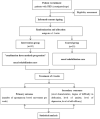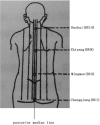The effect of the therapy of "combination 3 methods progression" in patients with neurogenic bowel dysfunction (constipated type): Study protocol for a randomized controlled trial
- PMID: 33607803
- PMCID: PMC7899824
- DOI: 10.1097/MD.0000000000024662
The effect of the therapy of "combination 3 methods progression" in patients with neurogenic bowel dysfunction (constipated type): Study protocol for a randomized controlled trial
Abstract
Background: As one of the important manifestations of neurogenic bowel dysfunction, constipation is characterized by high incidence and harmful effects. It has a negative impact on both physical and psychological health of patients. And there are no effective treatment options for this type of disease clinically. Therefore, this study is designed to examine the effect of the therapy of "combination 3 methods progression" in patients with neurogenic bowel dysfunction (constipated type).
Methods: This is a randomized, controlled, parallel-design clinical trial. A total of 60 patients with neurogenic bowel dysfunction (constipated type) will be randomly assigned to intervention group and control group. The control group will receive 4 weeks of usual rehabilitation care, the intervention group will receive 4 weeks of the therapy of "combination 3 methods progression" in addition to usual rehabilitation care. The primary outcome is the number of spontaneous bowel movement per week. Secondary outcomes are stool characteristics, degree of difficulty in defecation, level of anxiety, level of depression, and level of self-efficacy.
Discussion: The interventions of this protocol have been programmed to alleviate constipation in patients with neurogenic bowel dysfunction. Findings may provide preliminary evidence for clinical efficacy of the therapy of "combination 3 methods progression."
Trial registration: Chinese Clinical Trial Registry, IDF: ChiCTR2000041463. Registered on December 26, 2020.
Copyright © 2021 the Author(s). Published by Wolters Kluwer Health, Inc.
Conflict of interest statement
The authors have no conflicts of interest to disclose.
Figures






References
-
- Yeung HY, Iyer P, Pryor J, et al. . Dietary management of neurogenic bowel in adults with spinal cord injury: an integrative review of literature. Disabil Rehabil 2019;15:1–2. - PubMed
-
- Lynch AC, Anthony A, Dobbs BR, et al. . Anorectal physiology following spinal cord injury. Spinal Cord 2000;38:573–80. - PubMed
-
- Krogh K, Nielsen J, Djurhuus JC, et al. . Colorectal function in patients with spinal cord lesions. Dis Colon Rectum 1997;40:1233–9. - PubMed
-
- Ng C, Prott G, Rutkwski S, et al. . Gastrointestinal symptoms in spinal cord injury: relationships with level of injury and psychologic factors. Dis Colon Rectum 2005;48:1562–8. - PubMed
Publication types
MeSH terms
Grants and funding
LinkOut - more resources
Full Text Sources
Other Literature Sources
Medical
Research Materials

